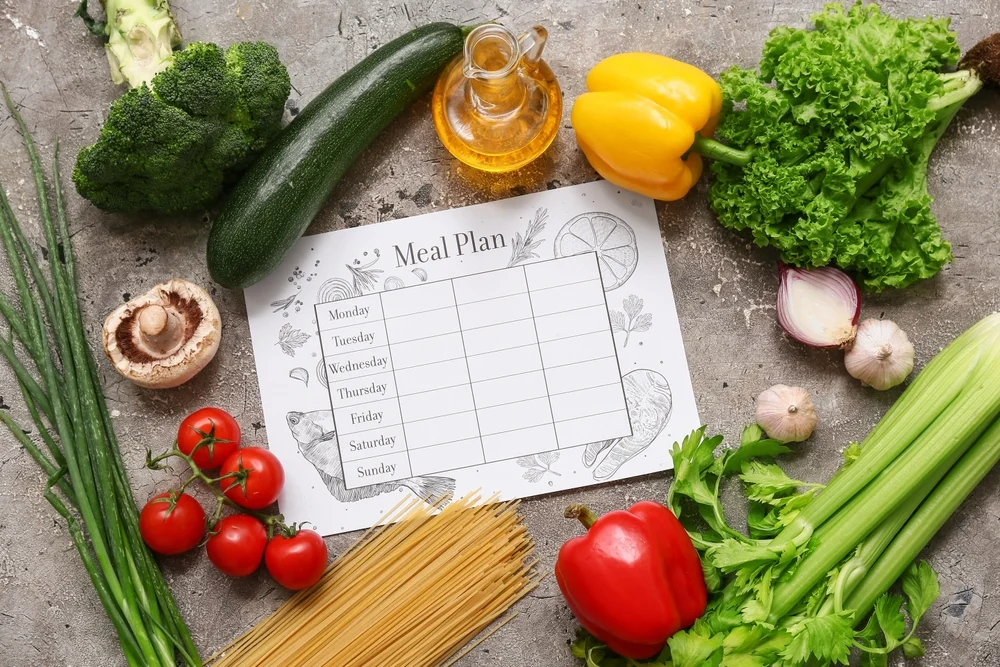How to Make a Budget-Friendly and Appealing Meal Plan
Families trying to eat better, cut stress, and save money often find great change in meal planning. Strategically choosing what and how you eat will help you simplify grocery shopping, cut food waste, and savor reasonably priced, great meals without going broke. This post will walk you through methodically developing a reasonably priced dinner schedule fit for your family. At the conclusion, you will get practical advice om how to make a budget-friendly and appealing meal plan and even a 7-day meal plan as sample to get you going.
Introduction: The Importance of Meal Planning
Meal planning is a useful tool to simplify your life rather than only a task. Here are a few main reasons why spending some time to arrange your meals will pay off:
- Saves Time: A well-defined diet simplifies your daily decision-making.
- Reduces Costs: Following a well-defined strategy can help you stay away from unneeded spending and impulse purchases.
- Minimizes Food Waste: Planning guarantees that you make good use of perishable items..
- Promotes Healthier Eating: It’s easier to balance nutrition when meals are thoughtfully prepared.
Meal planning especially helps families. Having a budget-friendly and appealing meal plan keeps everyone happy and well-fed without straying too far from their dietary tastes, different schedules, and rising appetites. Following this tutorial will teach you doable techniques to make family-friendly, efficient, and reasonably priced meal planning possible.

Steps to Create a Low-Cost Weekly Meal Plan
Developing a reasonably priced meal schedule is not as difficult as it would seem. These guidelines will help you to ensure a seamless and fulfilling process.
Step 1: Set a Realistic Food Budget
Create a weekly food budget before delving into dinner ideas. This stage guarantees your family gets healthy meals and helps you keep financial discipline.
- Determine Your Weekly Budget: Examine your monthly income and spending to set a reasonable grocery budget. Starting at 10 to 15 percent of your household income is a good place.
- Factor in Family Size and Needs: Think about family members’ count as well as any dietary preferences or limits. Depending on geography and dietary requirements, a family of four can target $100 to $150 weekly.
- Balance Nutrition and Cost: Give reasonably priced yet nutrient-dense foods include grains, legumes, seasonal vegetables, and lean proteins top importance. These reasonably priced, multipurpose basics are great.
Step 2: Take Stock of What You Already Have
Your cupboard, refrigerator, and freezer inventory will help you greatly lower expenses.
- Audit Your Pantry: Plan meals around things that are about to expire. A black bean can, for example, inspire a robust salad, chili, or tacos.
- Incorporate Leftovers: Get inventive with already prepared food. One can make soup, stir-fry, or sandwiches from leftover roasted chicken.
- Reduce Waste: Knowing what you already have helps you to maximize current resources and stop unneeded buying.
Step 3: Plan Meals Around Sales and Seasonal Produce
Use seasonal availability and promotions to extend your money.
- Check Flyers and Apps: Look for weekly bargains with grocery shop fliers or Flipp apps. Create your menu around specials such buy-one-get-one-free campaigns or proteins on sale.
- Embrace Seasonal Produce: Often more tasty, fresher, and more reasonably priced are seasonal fruits and vegetables. For summer, for instance, tomatoes and zucchini abound and reasonably priced.
- Buy in Bulk (When Practical): Bulk purchases can save a lot of money for non-perishables including canned goods, pasta, and rice. Just make sure you can store things.
Building This Week’s Menu: Affordable and Appealing Ideas
It’s easier than you would think to create a menu that strikes affordability, taste, and nutrition. Ideas for every meal of the day below may help you to plan.
Breakfast Ideas
Start your day with reasonably priced, healthy choices requiring little preparation:
- Overnight Oats: In a jar toss oats, milk, and a little cinnamon. For a filling beginning, top with sliced bananas or frozen berries.
- Egg Muffins: Bake in a muffin tray mixed eggs, chopped vegetables, cheese. These can be prepared ahead for hectic mornings.
- Smoothies: For a reasonably priced and nutrient-dense breakfast, toss frozen fruits, yogurt, a few spinach leaves.
Lunch Ideas
Should necessary, lunches should be quick, filling, and simple to pack:
- Leftover Remix: Create sandwiches, wraps, or salads with dinner leftovers.
- Grain Bowls: Start with cooked rice, quinoa, or couscous then toss roasted vegetables, beans, and a basic dressing.
- Homemade Soups: Made reasonably cheap and lasting several lunches, a pot of lentils or vegetable soup is ideal.
Dinner Recipes
Usually the focal point of the day is dinner. Some crowd-pleasers that won’t break the budget are:
- Stir-Fry: With a basic soy-based sauce, toss rice, frozen vegetables, and a protein such as tofu or chicken.
- Sheet Pan Meals: On one tray for simple cleanup, roast chicken thighs, potatoes, and veggies together.
- Pasta Night: Match reasonably priced spaghetti with a homemade marinara sauce, garlic bread, and a basic salad.
Snacks and Desserts
With these reasonably priced low-cost choices, satisfy appetites.
- Homemade Popcorn: On the stove, pop kernels and sprinkle nutritional yeast or cinnamon among other spices.
- Yogurt and Granola: Top plain yogurt with oats and honey drizzles.
- Baked Goods: To keep on hand for the next week, batch bake muffins or cookies.

Common Challenges in Meal Planning (and How to Overcome Them)
Meal planning can provide difficulties even with best of intentions. Here is how to address some often occurring problems:
Picky Eaters in the Family
- Solution: Make bespoke dishes including grain bowls, spaghetti bars and tacos. Provide a range of toppings so each person can create their own meal. To broaden their pallet, gradually add novel meals next to well-known favorites.
Staying Within Budget When Prices Fluctuate
- Solution: Keep your dinner schedule open-minded. Based on weekly sales, replace ingredients; choose reasonably priced substitutes like frozen vegetables rather than fresh.
Limited Time for Meal Preparation
- Solution: Choose basic dishes with less preparation time. While you work on other chores, cook meals using slow cookers or instant pots. On weekends, batch cook to save time during hectic weekday.
Tips for Family on Making a Budget-Friendly and Appealing Meal Plan
Use these ideas to help your meal planning process go smoothly and pleasantly:
Get the Whole Family Involved
Meal planning turns from a burden to a shared activity when everyone helps.
- Host Family Discussions: Get comments on preferred snacks or meals.
- Assign Roles: Children should assist with minor chores including table arrangement and snack selection..
- Plan Together: Map meals using a whiteboard or calendar to guarantee openness and feedback from every member.
Make a Shopping List and Stick to It
Your companion in staying on budget is a well-organized shopping list.
- Organize by Category: Sort goods into vegetables, dairy, meats, etc. to prevent running back into the store.
- Stick to Essentials: Steer clear of the temptation to include unneeded goods unless they are an amazing bargain.
- Shop Alone (if Possible): This lessens impulse buys and distractions..
Prep Ahead to Save Time
Meal or ingredient prep done ahead of time will save valuable time during hectic week.
- Batch Cooking: Get enough of basics like rice, beans, or grilled chicken ready for use all through the week.
- Chop Ahead: Cut vegetables ahead of use and keep them in sealed containers.
- Freeze Extras: Freeze portions for later use and double soups, casseroles, or pasta sauces.
Sample Low-Cost Weekly Meal Plan for Families
This is a useful seven-day dinner schedule to motivate your frugal path:
Monday
- Breakfast: toast with scrambled eggs on top of fruit as a side.
- Lunch: Made bread from scratch and lentil soup.
- Dinner: Roasted sweet potatoes and green beans accompany baked chicken thighs.
Tuseday
- Breakfast: Yogurt parfait topped with sliced banana and grains.
- Lunch: Grain bowl including salsa, black beans, roasted veggies, quinoa.
- Dinner: Homemade marinara sauce pasta with garden salad.
Wednesday
- Breakfast: Whole-grain bread with peanut butter and banana.
- Lunch: Cold leftover spaghetti worked great as a noodle salad.
- Dinner: Stir-fry tofu or chicken, frozen veggies, and rice.
Thursday
- Breakfast: Frozen berries on top of overnight oats.
- Lunch: Turkey and cheese wrap along with carrot sticks.
- Dinner: Chili made in a slow cooker with cornbread.
Friday
- Breakfast: Smoothie featuring yogurt, frozen fruit, and spinach.
- Lunch: Apple together with an egg salad sandwich.
- Dinner: Potatoes, mixed vegetables, and sausage cooked on a sheet pan.
Saturday
- Breakfast: A boiled egg with a muffin.
- Lunch: homemade minestrade soup..
- Dinner: Taco night featuring salsa, lettuce, and ground turkey.
Sunday
- Breakfast: Pancakes on one side accompanied by scrambled eggs..
- Lunch: Leftovers tacos became a taco salad.
- Dinner: Made baked ziti with steamed broccoli and garlic bread.

Conclusion: Enjoying Your Budget-Friendly Meal Plan
Meal planning need not be difficult or costly. Establishing a reasonable budget, inventory analysis, and seasonal ingredient planning help you to design a meal schedule that is both pleasing and reasonably cost-effective. Get your family involved in the process; follow a shopping list; and prep ahead to save time and work. Having a sample meal plan in hand and these ideas will help you to keep your budget happy while tackling the next week. Starting today, take the first step toward creating a reasonably priced dinner schedule. Share your suggestions in the comments or review our related pieces for yet more inspiration!
Bonus: Additional Resources for Family Meal Planning
Free Printable Meal Planning Templates
- Outline your weekly menu and grocery list using personalized templates..
- Accessible in styles suitable for different sized families and dietary choices.
Links to Budget-Friendly Recipe Websites and Apps
- Budget Bytes: Reasonably priced recipes with cost analysis.
- Mealime: a customisable menu-based meal planning application.
- Allrecipes: Sort recipes according to items you already own.
Tips for Long-Term Meal Planning Success
- Evaluate Regularly: Change your strategy depending on what performs and what doesn’t.
- Stay Flexible: Should things change, be ready to trade meals or ingredients.
- Stock Your Freezer: Always have on hand flexible foods like frozen vegetables and proteins.
Frequently Asked Questions (FAQs)
1. What is the best way to create a low-cost weekly meal plan?
Establish a budget first; then, inventory your pantry, then schedule meals using seasonal foods and sales.
2. How can I make family meal planning easier?
Use basic recipes, involve the entire family in meal selection, and prep items ahead of time.
3. What are some tips for sticking to a budget while grocery shopping?
Create a shopping plan, steer clear of impulse buys, and concentrate on flexible, reasonably priced products including rice, beans, and seasonal veggies.
4. What if I have picky eaters in my family?
Add known tastes, experiment with “build-your-own” dishes like tacos or grain bowls, and progressively add novel things.
5. Can meal planning really save money?
Yes. Meal planning guarantees you just buy what you need, helps you avoid eating out, and lowers food waste.
6. What are some quick and affordable meal ideas?
Pasta meals, stir-fries, casseroles, and low-cost soups all fit under examples here.



